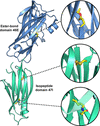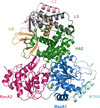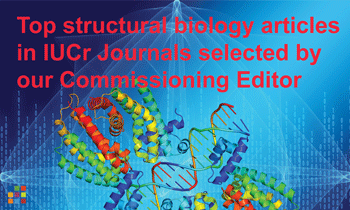issue contents
November 2023 issue

Cover illustration: A bacterial phosphotriesterase has been employed as an experimental paradigm to examine the effects of multiple factors, such as the molecular constructs, the ligands used during protein expression and purification, the crystallization conditions and the space group, on the visualization of molecular complexes of ligands with a target enzyme [Dym et al. (2023), Acta Cryst. D79, 992–1009]. A ribbon representation of a phosphotriesterase variant named A53_3 is shown. The presence of the octapeptide, from a symmetry-related subunit, in the active site explains why no bound organophosphates are found in space group P21 crystals.
research papers
Open  access
access
 access
accessCrystallographic structures of the (S)-enantioselective haloalkane dehalogenase DmmarA from the waterborne pathogenic microbe Mycobacterium marinum were determined at 1.6 and 1.85 Å resolution. The structures reveal a previously unobserved mode of homodimerization, which is predominantly mediated through unusual L5-to-L5 loop interactions.
Open  access
access
 access
accessAn adhesin from Mobiluncus mulieris, a bacterium associated with persistence in bacterial vaginosis, contains 51 repeat Ig-like domains. Each domain displays cross-linking including intramolecular ester, isopeptide, disulfide and thioester bonds. This giant 7651-residue protein, by far the largest in the bacterial proteome, is presumably retained because of its critical pathogenic role.
Open  access
access
 access
accessThe first crystal structures of the human, dog and cat DHX9 proteins were determined. The structures of mammalian DHX9 proteins share a similar structural fold with the previously reported structure of the Drosophila melanogaster DHX9 orthologue MLE. The human DHX9 structure provides a useful starting point for structure-guided drug design of DHX9 inhibitors.
Open  access
access
 access
accessThis study provides valuable insights into the challenges and considerations involved in the use of X-ray crystallography to study the 3D structures of ligand–protein complexes and highlights the importance of careful experimental design and rigorous data analysis in ensuring the validity of the structures obtained. A bacterial phosphotriesterase served as an experimental paradigm and novel insights were yielded into the role of the bimetal center of the enzyme in stabilizing the transition state for the hydrolysis of substrates.
PDB references: A53_1, 8p7f; A53_2, 8p7h; A53_3, 8p7i; A53_4, 8p7k; A53_5, 8p7m; C23_1, 8p7n; C23_2, 8p7q; C23_3, 8p7r; C23_4, 8p7s; C23_5, 8p7t; C23M_1, 8p7u; C23M_2, 8p7v
Open  access
access
 access
accessThis study presents the atomic X-ray crystal structures of wild-type Candida boidinii NAD+-dependent formate dehydrogenase (CbFDH) and its Val120Thr mutant, revealing new hydrogen bonds and increased stability in the active site of the mutant. These findings offer valuable insights for protein engineering, potentially improving the efficiency and electron transfer of CbFDH for applications in biofuel production and industrial chemical synthesis from carbon dioxide.
Open  access
access
 access
accessAnaerobic, room-temperature X-ray diffraction and absorption spectroscopy is performed using sandwiched silicon nitride membranes, prepared using 3D-printed tools, in an oxygen-free environment with a reducing agent. Using crystals of hemoglobin as a model system, it was demonstrated that this method ensures oxygen-free data collection.
Open  access
access
 access
accessThe first structural determination of the α(1,4)-linkage-specific fucoidan hydrolase Mef1 (GH107) is reported, including the positioning of two calcium sites and the two main amino acids involved in the active-site hydrolytic mechanism. The structural determination also led to the discovery of a water wire leading from the exterior into the active site of the enzyme.
PDB reference: Muricauda eckloniae endo-α(1,4)-fucoidanase, 8bpd
Open  access
access
 access
accessThe crystal structures of two disulfide-linked ubiquitin-bound bacterial deubiquitinases reveal the mode of ubiquitin binding. These structures show that disulfide linking is an effective strategy for capturing covalent ubiquitin–deubiquitinase complex structures.

 journal menu
journal menu


























